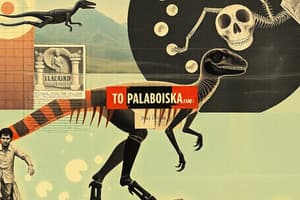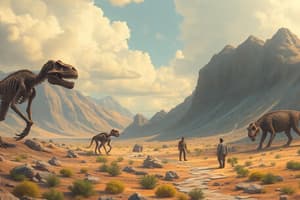Podcast
Questions and Answers
How does a cast fossil form?
How does a cast fossil form?
- When hard parts of an organism dissolve over time, leaving a hollow area
- As a result of a mold, with water and dissolved minerals filling empty spaces (correct)
- By breaking down materials of a buried organism, eventually leaving only carbon
- When water evaporates, only hardened minerals are left behind
What is the main characteristic of a carbon film fossil?
What is the main characteristic of a carbon film fossil?
- Shows only the footprint of an animal
- Consists of a thin layer of carbon that remains after breakdown of organic materials (correct)
- Contains hardened minerals from the surrounding sediment
- Preserves the organism in its original state
What is the purpose of trace fossils?
What is the purpose of trace fossils?
- To dissolve hard parts of an organism over time
- To fill the mold's empty spaces with water and sediment
- To preserve organisms in their original states
- To show the activities of organisms, like making footprints in sand or mud (correct)
In what way are preserved remains different from mold and cast fossils?
In what way are preserved remains different from mold and cast fossils?
How are fossils formed?
How are fossils formed?
What do fossils provide evidence of?
What do fossils provide evidence of?
What is a common misconception about fossil formation?
What is a common misconception about fossil formation?
What type of fossil formation involves minerals replacing all or part of an organism?
What type of fossil formation involves minerals replacing all or part of an organism?
Petrified fossils form when minerals replace all parts of an organism.
Petrified fossils form when minerals replace all parts of an organism.
Trace fossils are the only type of fossils that provide clues about past environments.
Trace fossils are the only type of fossils that provide clues about past environments.
Erosion plays a role in exposing preserved remains by adding more layers of sediment.
Erosion plays a role in exposing preserved remains by adding more layers of sediment.
Carbon films are formed when minerals replace the calcium phosphate in an organism's bones.
Carbon films are formed when minerals replace the calcium phosphate in an organism's bones.
A mold fossil forms when the hard parts of an organism are dissolved over time.
A mold fossil forms when the hard parts of an organism are dissolved over time.
A cast fossil is the result of filling a mold's empty spaces with water containing dissolved minerals and sediment.
A cast fossil is the result of filling a mold's empty spaces with water containing dissolved minerals and sediment.
Carbon film fossils are formed when the thin layer of carbon left behind dissolves over time.
Carbon film fossils are formed when the thin layer of carbon left behind dissolves over time.
Preserved remains always involve organisms being preserved close to their original states.
Preserved remains always involve organisms being preserved close to their original states.
An animal is buried by ________, such as volcanic ash or silt, shortly after it dies.
An animal is buried by ________, such as volcanic ash or silt, shortly after it dies.
More sediment layers accumulate above the animal’s remains, and minerals, such as silica, slowly replace the ________ in the bones.
More sediment layers accumulate above the animal’s remains, and minerals, such as silica, slowly replace the ________ in the bones.
Movement of tectonic plates lifts up the sediments and pushes the fossil closer to the ________.
Movement of tectonic plates lifts up the sediments and pushes the fossil closer to the ________.
Erosion from rain, rivers, and wind wears away the remaining rock layers. Eventually, erosion or people digging for fossils will expose the preserved ________.
Erosion from rain, rivers, and wind wears away the remaining rock layers. Eventually, erosion or people digging for fossils will expose the preserved ________.
A ______ forms when hard parts of an organism are buried in sediment
A ______ forms when hard parts of an organism are buried in sediment
Water with dissolved minerals and sediment fills the ______'s empty spaces
Water with dissolved minerals and sediment fills the ______'s empty spaces
A ______ is the opposite of its mold
A ______ is the opposite of its mold
A carbon-film fossil of a fern can show an organism’s delicate parts, like leaves on a ______
A carbon-film fossil of a fern can show an organism’s delicate parts, like leaves on a ______
Flashcards are hidden until you start studying




